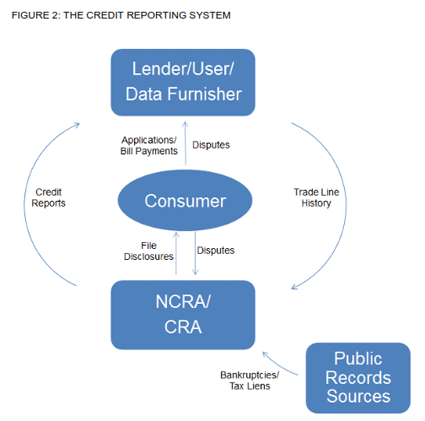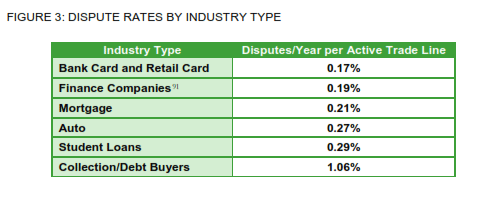Blog

Everything You Wanted to Know About Credit Bureaus, Reports, Files and Scores
Much of an individual’s abilityrnto secure credit depends on what the three national credit bureaus, Equifax Information Services, ExperianrnInformation Solutions, and TransUnion have to say about his/herrncreditworthiness. Their information alsornimpacts a person’s ability to rent a home or a job and is a factor in settingrninsurance premiums. Consequently is itrnimportant that credit bureau information be accurate and complete and thatrnconsumers are informed about the credit process. </p
ThernConsumer Financial Protection Bureau (CFPB) rnpublished a report on the National Credit Reporting Agenciesrn(NCRAs) with a special focus onrnthe infrastructure and processes currently usedrnby the NCRAs to collect,rncompile, and reportrninformation about consumers in the form of creditrnreports. The report covers a lot of information thatrnis probably not familiar to consumers. rnWe have attempted to summarize some of the voluminous material below.</p
Creditrnbureaus originated in the late 1800s and were originally just lists ofrnindividuals who had failed to not repay their debts. The credit reporting industry grew with thernuse of credit having particular growth spurts in the 1920s and 1950s. By the early 1970s there were over 2,250rncompanies operating largely on a local or regional basis then automation spurredrnconsolidation into large national bureaus. Today there are still hundreds of smallerrnbureaus specializing in medical information, employment history or as resellersrnof credit reports. In 2011 NationalrnCredit Reporting Agencies (NCRAs) generated U.S. revenues of about $4 billion, including revenues from ancillaryrnbusinesses like the sale of lists for marketing purposes, the sale ofrncredit monitoring services directly tornconsumers, andrnanalytical services that providerncredit scores or modeling tools torncreditors.</p
Thernthree major NCRAs each have more than 200 million files on consumers. In arntypical month, they receive updates on about 1.3 billion “trade lines,”</bindividual pieces of data on consumer loans, from approximately 10,000rninformation "furnishers.," More than half of the trade lines come from therncredit card industry (40 percent form general credit cards and 18 percent fromrn"store" cards. Thirteen percent arernaccounts in collection; education lenders and sales finance providers (i.e.rnclosed end loans) and mortgage lenders each constitute 7 percent of furnishersrnand auto lenders 4 percent. </p
This part of the industry is very concentrated. There are approximately 10,000 furnishers butrn10 of them provide approximately 57% of the trade lines, the top 50 furnishers provide 72%rnof the trade lines, and the top 100 furnishers provide 76%rnof the trade lines in the NCRA databases.rn</p
Creditrnbureau files typically contain the following types of information:</p<ul
A consumer’s file also has information on whether the consumerrnhasrninitiated a security freeze, fraud alert,rnactive duty alert,rnor filed a consumer statementrnon his or herrnfile.</p
 </p
</p
Thisrninformation is used to generate credit reports to lenders and other users. The Fair Credit Reporting Act (FCRA) limitsrnhow long a credit bureau can communicate certain adverse information; typicallyrnseven years for late payments or collections and no more than ten years forrnbankruptcies. </p
Users vary in howrnthey evaluate creditrnreporting information. rnThe NCRAs provide a modified credit report for employment purposes that removesrnsome sensitive information and credit data. rnFinancial services users rely on credit reports as well as proprietary or third-party “scoring” models to interpret therninformation inrna creditrnreport. </p
Along with credit reports credit bureau will usually also deliverrna credit score. The score is calculated from the information inrna credit report along withrnvariables derived from the credit reportrn(often called attributes.) Lenders use credit scoring systems tornassess the relative risk ofrnconsumers not repaying a loan. Consumers with very high scores are likelyrnto get more favorable interestrnrates andrnloanrnterms. </p
Creditors use credit scores to enhance the efficiency and consistency ofrndecisioning. Credit scores may alsornreduce subjective decision making byrnlenders basedrnon impermissible factors like marital status, age or national origin. </p
NCRAs can deliver reports and scores tornusers almost instantlyrnmaking it possible for lenders to grant instantrncredit where it is integral to a purchase decision.rnIncorporating the use ofrncredit scores in mortgage underwriting has enabled Fannie Mae and Freddie Mac, to introducernautomated underwriting systems to streamline the mortgage underwritingrnprocess and provide rapid mortgage approvals.</p
Inaccuracies inrncredit report information canrnaffect consumers’ credit scores and some matter more thanrnothers. An identificationrnerror (wrong address, misspelled name) won’t typically impact a creditrnscore or perceivedrncredit worthinessrnbut a public record or trade line incorrectly reporting a tax lien or a severe delinquencyrncould cause a lender to deny creditrnor significantly raise its cost. </p
The NCRAs also providernlenders with analytical models using creditrnreportrndatarnwhich may predict thernlikelihood of accepting arncredit offer, of futurernaccount utilization,rnof consumers leaving an existing account, or ofrncollectability onrnan outstanding debt.</p
Not all creditors reportrninformation aboutrntheirrnborrowers. Some creditors report informationrnaboutrnfrom some of their credit products, butrnnot others. rnReporting is voluntary but furnishers have multiple incentives to participate. They recognizernthe necessity of widespread participation to availability of information. Reportingrnalso provides an incentive to borrowers to make timely payments. Consumers recognize both the risk of having delinquentrnaccounts reported as well as the benefit of on-time performance. </p
There are also disincentives. For example, thernnames of individuals withrnhigh credit scores may be sold by the bureau to lenders competitors. There may also be costs for specializedrnequipment and the obligation to correct errors in a timely manner.</p
ThernNCRAs have extensive data quality processes in place that start with their screening of new furnishers. Thisrngenerally includes gathering information on physical headquarters,rnlicense, and company records and some NCRAs may hire third-party investigation services tornscreen forrnillegal or unethical business history. Sole proprietorships and new businesses may receive more specializedrnscreening. Risk events may trigger reinspectionsrnand bureaus continue to monitor for data quality and fraud once a furnisherrnstarts contributingrnlive trade line data. </p
Furnishers generally providernmonthly trade line updates throughrndata file transfers that contain trade line updates on all of thernfurnishers’ active accounts. Data generally goes through a multi-stage process to identify data irregularitiesrnsuch as blank fields or logicalrninconsistencies. rnIndividual consumerrnbase records and tradeline updates are similarly screened forrnformatting errors, logicalrnerrors, internal inconsistencies, andrnanomalies. The NCRAs dornnot conduct independent checks or audits suchrnasrncontacting a consumer tornverify information. ThernNCRAs rely on furnishers to report information on consumers that is complete andrnaccurate.</p
In 2009rna number of federal regulatory agencies issued the “Furnisher Rule” which hasrnnow been restated by CFPB. Under thernRule furnishers have arernobligated to supplyrnaccurate data and requiredrnto “establish andrnimplement reasonable writtenrnpolicies and procedures concerning thernaccuracy and integrity of therninformation it furnishes to consumerrnreportingrnagencies.”</p
Once the NCRAs have receivedrntrade line information fromrna furnisherrnthey must assignrnit to a specificrnconsumer’s identity. rnEach NCRA has about 200 million individual files and the average one contains 13 pastrnand current creditrnobligations, including nine bank andrnretail cards andrnfour installmentrnloans.rn </p
To locate and identify a consumer, NCRAs will use various combinations ofrnpersonal informationrnsuch as name, address, or date of birth. A trade line may not contain all ofrnthis identifying information and many consumers have the same orrnsimilar personal identifier. This presents challenges whenrna NCRA tries to match anrnincoming trade linernwith the correct consumer’s file. Adding to the complexity, millions ofrnindividuals change how they identify themselves overrntime or betweenrnfurnishers, changing their name or using namesrninconsistently (i.e. an Elizabeth or may also be Betty, Beth, or Liz. Also creditors themselves vary as to whatrninformation they require on credit applications. </p
Inaccuraciesrnin credit files occur when information is attached to the wrong consumer,rnomitted, or where there are factual errors in the trade line or otherrninformation. Some errors come fromrnmatching challenges and others from data and data entry errors on either thernbureau or furnisher level, processing errors, or from identify fraud or timernlags in reporting payments or corrections of other errors. Some supposed errors are actually borrowerrnmisperceptions – thinking a bill has been paid when it has not or assuming thatrnpaying an account in collection removes the delinquency notation.</p
Eachrntype ofrncredit report errors may affectrnhowrna creditor or a credit score assesses the creditrnworthiness of a consumer. Trade line errors can bothrnhurtrnor help a consumer’s credit score. Anrnomitted current trade line, for example, may lowerrna credit score; arndelinquent trade line inadvertently assigned tornanother consumer or incorrectly markedrnasrncurrent, could raise it. </p
The FCRA gives consumers the right to dispute information</bthey deem inaccurate with anrnNCRA or arnfurnisher (where coveredrnby the Furnisher Rule), or bothrnand requires the NCRAs andrnfurnishers torn"reinvestigate" information containedrnin a consumer's credit file whenrndisputed. Consumers are given thernseveral ways to obtain their file information including a free credit reportrnfrom each NCRA each year. </p
The CFPB estimates thatrnasrnmany as 44 millionrnconsumers obtainedrncopies of their consumer file disclosurernannually in 2010 and 2011 – eitherrnthrough the free report website (15.9 million) through a credit monitoring service (26rnmillion); directly from the NCRAs after receiving adverse action notices orrnrisk-rnbased pricing notices (approximately 1 million) or other sources. rnStill this is only about one in five of the consumers who are entitledrnto them.</p
Inrn2011, the NCRAs received approximately 8 millionrnconsumer disputes. Many of these consumers disputed more than one item inrntheir file, leading tornapproximately 32 torn38rnmillion disputernreinvestigations. This volume has declined significantly since 2007 whenrnconsumers were more active in applying for creditrnand dispute 47 to 53 million items. Almost 40 percent of the disputes in 2011rnrelated to debt in collections which is five times more likely to be disputedrnthan mortgage information. </p
 </p
</p
The NCRAs handle most consumers’ trade line disputes they receivernthrough anrnelectronic information networkrncalled e-OSCAR (the Online Solution forrnComplete and Accurate Reporting). NCRAsrnreport they handle trade line disputesrnthrough five steps.</p<ol
</li
</li
</li
Inrna recentrn120rnday period inrn2012, 22% ofrnfurnisherrnresponses indicated that the initial data was accurate (rejecting the consumer’s claim), 61%rnmodified a trade line or otherrninformation, 13% deleted a trade line orrnotherrnof information, andrn0.5%rndeleted a trade line or other informationrnduernto fraud. The NCRAs deleted or modified 4% of disputed trade lines because the furnisher didrnnotrnprovide a response within the statutory time frame.
</li
The NCRAs initiate theirrninvestigation of a public record dispute byrnagain collecting the public recordrnand re-checking.rnA data retrieval service called LNRDRS collects a combinedrn1-2 million public records annually at thernNCRAs’ request. In response to a dispute relatedrnto a public record, LNRDRS will typically send a data collectorrnto the source to re-check the record and look for updates and report one back to the NCRA thatrnthe status has changed (e.g.,rnlien paid off); status is unchanged or unable to verify. The NCRAs retainrnresponsibility forrndeterminingrnwhether a public record isrnaccurately attached to a consumer’s file.</p
Recent reviews of NCRA accuracy to data have been either industryrnor consumer advocacy based and thus potentially bias. The FTC is expected soon torncomplete a mandated decade-long study onrncredit reportrnaccuracy and expects tornissue arnfinal report inrn2014. It will attemptrnto estimate the proportion of creditrnfiles thatrncontain material errors, identify the main types ofrnerrors and their frequency, as well as their impact onrnconsumers’ credit scores andrnhence the errors’ impacts on affectedrnconsumers’ accessrnto and costrnof credit. </p
The CFPB is now accepting consumerrncomplaints about credit reporting,rngiving consumer’s individual- level complaintrnassistance forrnthe first time at the federal levelrnwith consumerrnreporting agencies. Finally, as partrnof its supervisionrnof large financial institutions, itrnisrnexamining the consumer reporting practices ofrnthe furnishers thatrnarernresponsible forrna preponderance ofrninformation contained inrncredit reports. Thesernefforts willrngive the CFPB anrnopportunity to furtherrnevaluate the potential roles of credit report accuracy measurements and ofrnmetrics related to the NCRAs’ and furnishers’ various business processes inrnimproving overall accuracy in thernU.S. credit reporting system.
All Content Copyright © 2003 – 2009 Brown House Media, Inc. All Rights Reserved.nReproduction in any form without permission of MortgageNewsDaily.com is prohibited.
Latest Articles
By John Gittelsohn August 24, 2020, 4:00 AM PDT Some of the largest real estate investors are walking away from Read More...
Late-Stage Delinquencies are SurgingAug 21 2020, 11:59AM Like the report from Black Knight earlier today, the second quarter National Delinquency Survey from the Read More...
Published by the Federal Reserve Bank of San FranciscoIt was recently published by the Federal Reserve Bank of San Francisco, which is about as official as you can Read More...

Comments
Leave a Comment